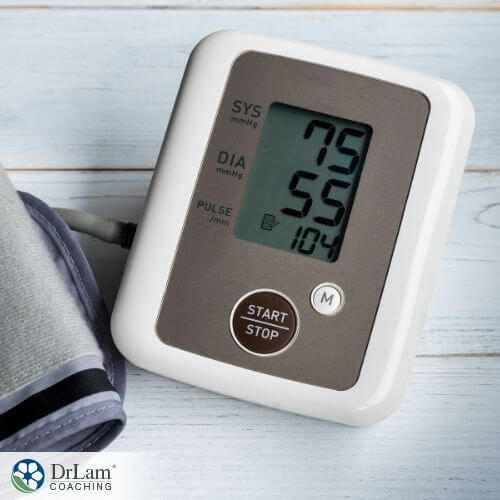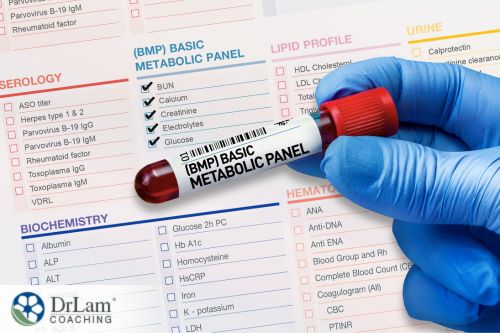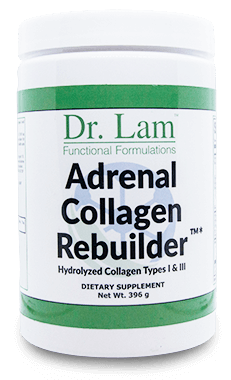 Blood pressure constitutes one of the key vital signs of life, along with heartbeat, rate of breathing, and temperature. It's generated by the heart pumping blood into the arteries and is regulated by the response of the arteries to the flow of blood. Your blood pressure is expressed as a systolic/diastolic number, for instance, 120/80 mmHg. Generally speaking, normal blood pressure is lower than 120/80, while high blood pressure is above 130/80, and low blood pressure is below 90/60 mmHg. However, this is not a concern simply because of a blood pressure number but because of the symptoms associated with it.
Blood pressure constitutes one of the key vital signs of life, along with heartbeat, rate of breathing, and temperature. It's generated by the heart pumping blood into the arteries and is regulated by the response of the arteries to the flow of blood. Your blood pressure is expressed as a systolic/diastolic number, for instance, 120/80 mmHg. Generally speaking, normal blood pressure is lower than 120/80, while high blood pressure is above 130/80, and low blood pressure is below 90/60 mmHg. However, this is not a concern simply because of a blood pressure number but because of the symptoms associated with it.
Low blood pressure, also medically referred to as hypotension, occurs when your blood pressure is significantly lower than normal. When this happens, your heart, brain, and other parts of your body may lack adequate blood supply.
However, it is not defined by a specific blood pressure number or by blood pressure readings below a certain threshold. Instead, it’s defined primarily by symptoms. What is okay for one person may be a sign of a problem in someone else.
Some people, for example, typically experience hypotension but are nonetheless healthy individuals and are asymptomatic. They may have a blood pressure reading of 90/50 but lack symptoms. As such, from a clinical standpoint, they do not have a problematic condition.
Still other people who usually experience high blood pressure may develop symptoms if their blood pressure falls to 100/60. Furthermore, according to an article in StatPearls, hypotension can "be absolute with changes in systolic blood pressure to less than 90 mm Hg or mean arterial pressure of less than 65 mm Hg. It may be relative to a decrease in diastolic blood pressure to less than 40 mm Hg."
That said, if you do have these signs, it may be a problem for you. Some common signs that your blood pressure is low include:
Different people experience hypotension differently because there are different types and causes. For instance, if you experience a drop in blood pressure of 15 mmHg, you may not have any serious problems, but in someone else, this could be a serious issue.
This can be the result of sudden loss of blood (shock), heart attack, severe allergic reaction (anaphylaxis), or severe infection.
This drop in blood pressure occurs when you shift from lying down or sitting position to standing. It typically lasts only between a few seconds and a few minutes. This form of hypotension may result from dehydration, certain medicines, long-term bed rest, pregnancy, and certain medical conditions. Furthermore, postural hypotension is common in older adults, and people with conditions like Parkinson’s disease, type-1 diabetes, and carotid artery stenosis (1).
This type of hypotension usually occurs when there is a drop in blood pressure within 15-120 minutes of eating. However, this type most often affects older adults and those with underlying health issues like high blood pressure and Parkinson's disease.
 This is a blood pressure drop that happens after standing for long periods. Research suggests that it might occur as a result of miscommunication between the heart and the brain. This drop in blood pressure is most often present in young adults and children. Children normally outgrow this form of hypotension.
This is a blood pressure drop that happens after standing for long periods. Research suggests that it might occur as a result of miscommunication between the heart and the brain. This drop in blood pressure is most often present in young adults and children. Children normally outgrow this form of hypotension.
Also referred to as Shy-Drager syndrome, this is a rare disorder that impacts the nervous system that’s responsible for controlling involuntary functions. The functions include blood pressure, breathing, digestion, and heart rate. It's also linked to significantly high blood pressure while lying down.
Several conditions can cause drops in blood pressure that can be problematic.
A drop in your blood pressure can occur when your body doesn't have enough water, causing your blood volume (the amount of blood in the body) to decrease. Also, it can cause a reduction in cardiac output (the amount of blood pumped by the heart). Dehydration can be the result of fever, severe diarrhea, strenuous exercise, vomiting, and overuse of diuretics. According to an article in Physiological Reports, dehydration decreases cardiac output, arterial blood pressure, and blood flow during intense prolonged exercise in the heat.
Heart disease including arrhythmias (changes in heart rhythm), bradycardia, heart block, weakened heart muscle, pericarditis, and tachycardia can contribute to low blood pressure. With any of these conditions, your heart cannot maintain the stroke volume to adequately supply blood flow to your body. Arrhythmia is more common in people with autonomic nervous system (ANS) dysfunction. Persistent overtones of the sympathetic nervous system (SNS) increase the release of norepinephrine. When chronic increases of norepinephrine occur, this can reduce the heart's threshold for cardiac arrhythmia.
Certain medications including beta-blockers like atenolol (Tenormin) and propranolol (Inderal, Innopran XL, Hemangeol), calcium channel blockers, and digoxin (Lanoxin) can slow the rate at which your heart contracts. Elderly people are more susceptible to the effect. Additionally, some medications used for hypertension can excessively lower blood pressure and cause symptomatic low blood pressure. Water pills (diuretics) like furosemide (Lasix) can reduce blood volume by causing excessive urination. Medications for Parkinson's disease, like levodopa-carbidopa (Sinemet), and medications for depression, such as amitriptyline (Elavil), and tricyclic antidepressants, such as doxepin (Silenor) and imipramine (Tofranil), can result in low blood pressure. Furthermore, drugs taken for erectile dysfunction can significantly lower blood pressure, including sildenafil (Revatio, Viagra) or tadalafil (Adcirca, Alyq, Cialis), particularly when taken with the heart medication nitroglycerin (Nitrostat, Nitro-Dur, Nitromist).
There are numerous other causes of hypotension, including:
Following a full conventional medical investigation where there’s an absence of any of the above-mentioned causes, adrenal fatigue may also be considered. However, it's critical to find the cause so that it can be remedied.
 Your healthcare provider may examine you to uncover the cause of your blood pressure being low. Checks on your vital signs, including blood pressure, pulse, rate of breathing, and temperature, are typically performed. These may be done regularly. Depending on your vital signs reading, your healthcare provider may recommend a stay in the hospital. Also, as part of your assessment, you may be asked questions related to your normal blood pressure readings, medications you might be taking, changes in your eating and drinking, other symptoms that you may be having, or any health issues that you may have experienced recently.
Your healthcare provider may examine you to uncover the cause of your blood pressure being low. Checks on your vital signs, including blood pressure, pulse, rate of breathing, and temperature, are typically performed. These may be done regularly. Depending on your vital signs reading, your healthcare provider may recommend a stay in the hospital. Also, as part of your assessment, you may be asked questions related to your normal blood pressure readings, medications you might be taking, changes in your eating and drinking, other symptoms that you may be having, or any health issues that you may have experienced recently.
To get answers about the cause of your hypotension, your healthcare provider may require the following tests:
Adrenal Fatigue Syndrome (AFS) is the non-Addison's form of adrenal dysfunction, where the body's stress response cannot keep up with life's chronic stressors. AFS begins when stress sends your body into "fight or flight" mode, releasing cortisol and other hormones to address a stressor. When stress is chronic, however, the body can begin to dysregulate as it becomes unable to keep up with demands for needed stress hormones. The Cardionomic circuit comprises the adrenal glands, cardiovascular system, and autonomic nervous system. This circuit forms part of your body’s NeuroEndoMetabolic(NEM) stress response, which tackles stress that your body encounters.
A drop in blood pressure can result from different conditions that place physical stress on your body. Several hypotension symptoms are common with adrenal fatigue. Symptoms could result from low levels of adrenal hormones like aldosterone, norepinephrine, and epinephrine. These hormones all moderate cortisol's effect. So, when the adrenals overwork, they can't perform well and cortisol levels drop, which can cause your blood pressure to drop. As such, it is crucial to fix adrenal issues. In adrenal fatigue, aldosterone can sometimes be affected. Aldosterone is important in salt regulation and therefore the hydration status of an individual. When someone can't keep salt in their system very well, then the water doesn't stay either, causing blood pressure to drop. Those with adrenal fatigue who have low blood pressure and dizziness can try taking some salt water throughout the day to see if their symptoms improve with the guidance of an experienced practitioner.
If you experience any of the following with hypotension, go to the emergency room (ER) right away:
A healthy person who experiences a drop in blood pressure that does not cause any symptoms does not usually need to take any action. However, it can become a problem for some people. In general, it's best to contact your doctor if you have symptoms of low blood pressure, as your condition may require medications to remedy the issue. The cause of a drop in your blood pressure and symptoms will also determine how you address it.
When you experience symptoms of hypotension like dizziness, immediately sit or lie down for a few minutes. Then, elevate your feet, raising them above your heart level. When your blood pressure is low and you feel dizzy after standing too quickly, you may be able to make certain changes to help. Here's a look at some strategies to try depending on your circumstances:
 If your medication is the culprit, your doctor may adjust the dosage or switch you to a new medicine. First, talk with your doctor before you stop taking any medication.
If your medication is the culprit, your doctor may adjust the dosage or switch you to a new medicine. First, talk with your doctor before you stop taking any medication.By itself, a lower-than-normal drop in blood pressure isn't usually alarming unless it's accompanied by other concerning symptoms. If you lose consciousness or experience dizziness, lightheadedness, nausea, vomiting, or other symptoms, do see your healthcare provider. Low blood pressure can stem from various causes, including medications, dehydration, and heart disease, which is why it's important to identify what is causing your symptoms. While strategies like standing slowly and increasing salt intake can help, it's important to discuss your symptoms and options related to your hypotension with your doctor to get your health back on track.
To learn more about managing adrenal fatigue and related symptoms like low bliood pressure, consider reaching out to our office at +1 (626) 571-1234 or exploring our Adrenal Fatigue Nutritional Recovery Program, which provides a holistic approach to wellness with a month's supply of specialized supplements, the Adrenal Fatigue Syndrome eBook, educational videos, nutritional and exercise guides, sleep improvement strategies, online learning with lifetime access, and additional support through personalized consultations and stress management resources, designed to rejuvenate energy levels and adrenal function.
Take proactive steps towards reclaiming your health and vitality today.

Adrenal Collagen Rebuilder harnesses the potential of collagen to help build up blood vessel wall strength and boost energy.
Sharma, S., Hashmi, M. F., Bhattacharya, P. T. “Hypotension.” StatPearls, StatPearls Publishing, 19 Feb. 2023, https://www.ncbi.nlm.nih.gov/books/NBK499961/.
Watanabe, Kazuhito, et al. “Dehydration Reduces Stroke Volume and Cardiac Output during Exercise Because of Impaired Cardiac Filling and Venous Return, Not Left Ventricular Function.” Physiological Reports, vol. 8, no. 11, 2020, https://doi.org/10.14814/phy2.14433. Accessed 12 Dec. 2023.
Wieling, Wouter, et al. “Diagnosis and Treatment of Orthostatic Hypotension.” The Lancet. Neurology, vol. 21, no. 8, 2022, p. 735, https://doi.org/10.1016/S1474-4422(22)00169-7. Accessed 12 Dec. 2023.
Low blood pressure symptoms include blurry vision, confusion, dizziness, fainting, lightheadedness, nausea, vomiting, sleepiness, weakness, fatigue. Address this issue by talking to your doctor about adjusting the dosage or switching your medication, following a healthy diet, staying hydrated, increasing salt intake, avoiding alcohol, and slowly standing from sitting or laying down.


Adrenal Collagen Rebuilder harnesses the potential of collagen to help build up blood vessel wall strength and boost energy.
